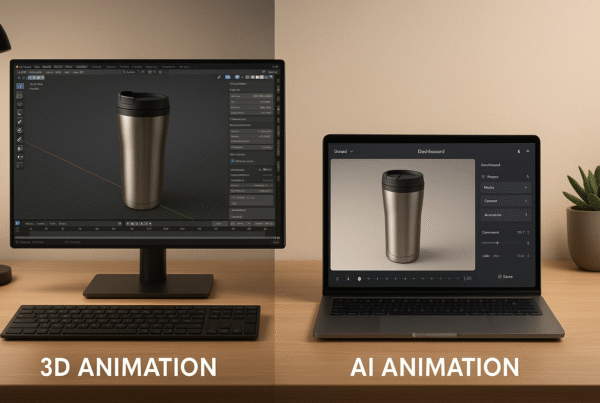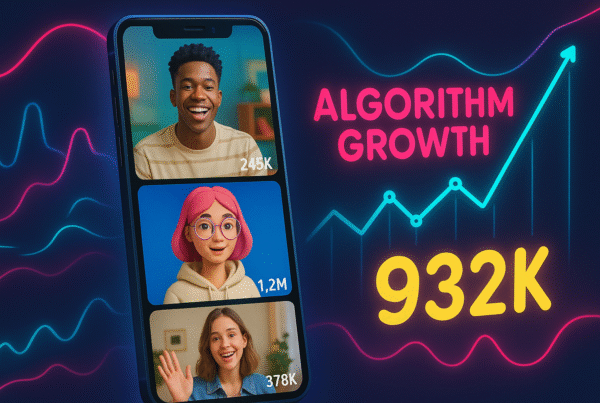Over 75% of households in the US have at least one form of outdated video media, according to a 2021 study by the National Digital Stewardship Alliance. If you’re among these millions of Americans with cherished memories trapped on deteriorating VHS tapes, a VHS video restoration app might be exactly what you need.
AI video restoration has revolutionized the preservation of our past, utilizing artificial intelligence to repair, enhance, and upscale damaged or low-quality footage. Nearly 40% of American households have already attempted to restore home videos using software or online services. The process typically involves damage detection, data training, and refinement to not only preserve these memories but also significantly improve their quality.
With the advancement of mobile technology, you no longer need expensive equipment or technical expertise to restore your old tapes. The basic hardware for excellent-quality restoration, once costing around $400, has become more affordable and accessible with today’s smartphone apps. Understanding modern VHS restoration techniques can help you choose between DIY and professional options. In this guide, you’ll discover the eight best VHS video restoration apps, from user-friendly options like 4DDiG Video Repair to advanced AI-powered solutions that can upscale your family videos to stunning 4K resolution.
The Problem with Old VHS Tapes
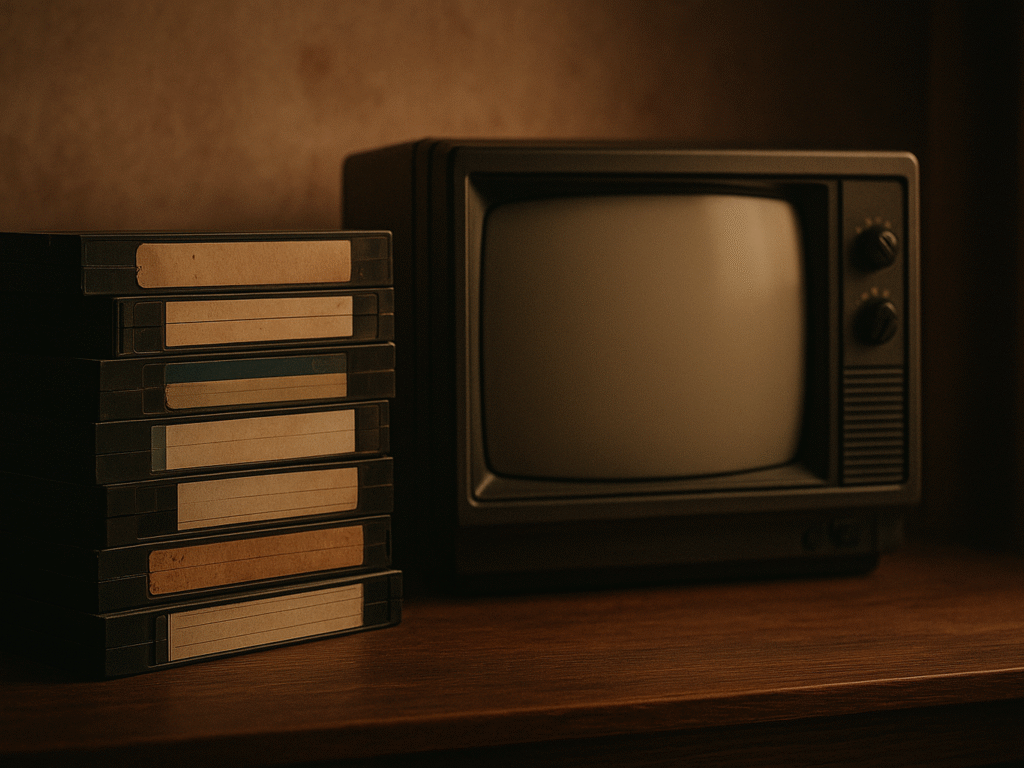
Those cherished family memories stored on VHS tapes are deteriorating right now – even as you read this. Unlike digital media, VHS tapes have a finite lifespan and are subject to inevitable degradation through both natural and mechanical processes. Understanding this deterioration is crucial before exploring how modern VHS video restoration apps can help rescue your precious memories.
1. Why do VHS tapes degrade over time?
VHS tapes degrade due to remanence decay, the gradual loss of magnetic charge in the tape’s particles, causing visual and audio distortion. Even under ideal storage, tapes can lose 10–20% of their quality over two decades, especially when their internal lubricants begin to dry out.
Environmental conditions worsen this process. Heat, humidity, and magnetic exposure lead to sticky-shed syndrome, making tapes unplayable. Frequent rewinding or overwriting footage causes physical wear, stretching, and tracking issues. As a result, your most-watched or frequently recorded tapes tend to deteriorate faster than those that are played rarely.
2. Common issues: noise, blur, color loss
As VHS tapes age, they develop various visual and audio issues that VHS restoration software aims to address. The most noticeable problems include:
- Image instability: Degraded tapes often display shaky footage that jumps around on screen
- Color distortion: Remanence decay causes color shifts toward weaker hues as magnetic particles lose their charge
- Detail loss: Fine details gradually disappear as the magnetic information deteriorates
- Audio degradation: Sound becomes muffled or distorted, sometimes completely out of sync with video
Physical damage can lead to visible issues, such as black bars and image distortion. Excessive playback exacerbates these issues, while exposure to moisture can lead to mold growth that damages the oxide layer. This results in tapes sticking, tearing, or becoming permanently unreadable over time.
Tracking errors often show up as horizontal color bleeding or ringing artifacts. As tapes degrade, visual clarity fades. Storing them in stable, dry conditions helps, but accurate preservation comes from digitizing. VHS restoration apps not only convert tapes but also repair common degradation effects, extending the lifespan of your memories.
How Mobile Apps Are Changing VHS Restoration
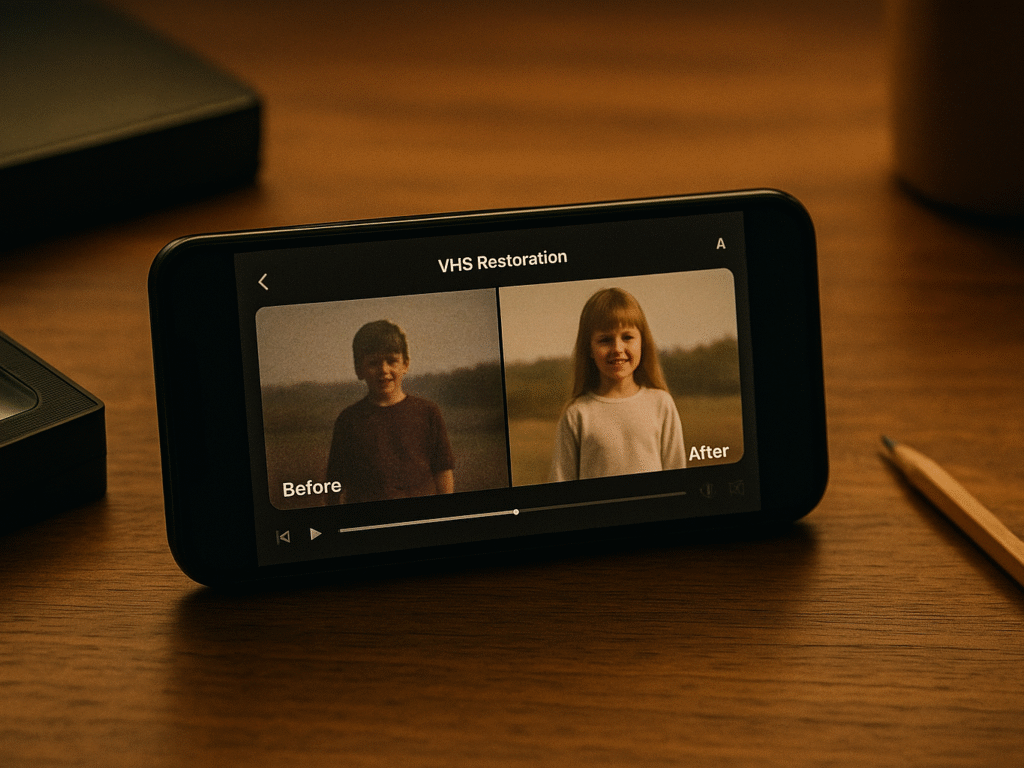
The VHS restoration landscape has undergone a dramatic shift in recent years. What once required specialized equipment and technical knowledge has now become accessible through the smartphones in your pocket. This technological evolution is reshaping how millions preserve their analog memories.
1. From desktop to mobile: the shift
Traditional VHS restoration previously demanded powerful desktop computers, expensive software, and specialized capture hardware costing upwards of $400 for basic setups. Today, this process has largely migrated to mobile platforms, creating an entirely new ecosystem for video restoration. Rather than requiring separate digitizing equipment and complex software, today’s VHS video restoration apps combine multiple functions into streamlined mobile experiences.
This mobile transition offers significant advantages beyond mere convenience. Specifically, restoration projects that once took months of manual work can now be completed in hours through automated processes. Exploring comprehensive restoration software options reveals how technology has transformed this field. Previously, restoring a single 90-minute film could cost hundreds of thousands of dollars when done professionally. With mobile solutions, these costs have dropped dramatically, making preservation accessible to average households rather than just professional studios.
2. AI-powered features on smartphones
The most remarkable advancement in mobile VHS restoration comes from artificial intelligence. For instance, iMemories’ McKenzie AI technology demonstrates how sophisticated these mobile solutions have become. This AI system can quadruple pixel counts to upscale standard definition footage to HD resolution. The technology can deliver up to three times the visual clarity compared to original videos.
Modern mobile AI restoration tools offer impressive capabilities:
- Automatic damage detection and repair
- Frame-by-frame enhancement and denoising
- Color correction and accuracy improvement
- Detailed recovery and sharpening
These AI models intelligently analyze each video frame to address common VHS problems: low resolution, blurry details, noise, and artifacts. Notably, this happens completely automatically, requiring minimal user intervention. The technology doesn’t just preserve your memories, it actively improves them by removing imperfections while maintaining the authentic feel of the original footage.
VHS Video Restoration: Complete Guide to Restoring Old Tapes (2025): Discover comprehensive restoration techniques, equipment recommendations, and step-by-step processes for digitizing your entire VHS collection. Discover professional secrets for achieving optimal quality results from deteriorating tapes by comparing different approaches and tools.
3. Accessibility for non-tech users
Perhaps the most profound change is how these apps have democratized restoration technology. You no longer need technical expertise or specialized knowledge to achieve professional-quality results. Mobile interfaces have been designed with simplicity in mind, offering guided processes that walk you through each step.
Additionally, the streaming capabilities of modern apps enhance accessibility after restoration. Once digitized, your memories become available across multiple devices, allowing you to watch your restored family videos on smartphones, tablets, and even stream them directly to smart TVs. It creates an experience similar to using popular streaming services like Netflix or Disney+, making your archive as accessible as professional content.
The resulting democratization means that what was once exclusive to high-end production studios is now available to anyone with a smartphone. This shift represents a fundamental change in how we preserve our visual history, ensuring that precious memories trapped on deteriorating VHS tapes can be saved and enhanced for future generations.
What to Look for in a VHS Restoration App

Selecting the right VHS video restoration app can make the difference between merely digitizing old tapes and truly reviving them. With numerous options available, understanding what features truly matter will help you choose a solution that delivers the best results for your cherished memories.
1. Ease of use and interface
The interface of your VHS restoration app should be straightforward yet powerful. Most quality VHS apps feature clean, simple designs that resemble the screen of an old-school camcorder, making them instantly familiar and approachable. The best apps offer streamlined workflows that allow you to easily apply effects and initiate the restoration process with just a few taps.
Look for apps that provide “one-click” restoration options. For instance, some tools let you simply “chuck your video at it, pick your desired resolution, and let the AI do its thing” without requiring technical expertise. This approach is particularly valuable since you’ll likely be processing multiple tapes over time.
Subsequently, consider whether the app offers real-time previews of enhancements. This feature enables you to view results before committing to lengthy processing times, making it especially helpful when working with extensive video collections. A quality app should provide intuitive controls for switching filters, starting or stopping processing, and adding effects without devastating you with technical jargon.
2. Support for upscaling and denoising
The core restoration capabilities of any worthwhile VHS app should include AI-powered upscaling and denoising functions. Top-tier apps can upscale standard-definition VHS footage (typically 480p) to modern resolutions, such as 1080p, 4K, or even 8K.
Beyond resolution improvements, effective apps offer:
- Denoising capabilities that remove the characteristic grain and static common in VHS recordings
- Deblurring technology that sharpens fuzzy footage and restores clarity
- Color enhancement that revives faded hues and corrects color shifts
- Face restoration features that improve the clarity of people in your videos
The processing speed matters as well. Advanced apps utilize GPU acceleration, performing video enhancement up to 50 times faster than standard software. This acceleration transforms what was once a days-long process into something completed in hours or even minutes.
3. Compatibility with digitized VHS files
Your restoration software must work seamlessly with already-digitized VHS content. The best apps support various input formats, as VHS tapes may have been digitized using different methods over the years. As such, look for apps that accept standard video formats, such as MP4, AVI, MOV, and MKV.
Equally important is whether the app can handle interlaced video, a common characteristic of VHS recordings. Quality restoration software should offer deinterlacing options that automatically eliminate the characteristic horizontal lines often present in many digitized VHS tapes.
Finally, consider output options and storage solutions. After restoration, you’ll want flexibility in how you save and share these memories. The most versatile apps allow exporting to modern formats compatible with smartphones, tablets, and smart TVs, ensuring your restored memories are accessible across all your devices.
Best VHS Video Restoration Apps (2025)
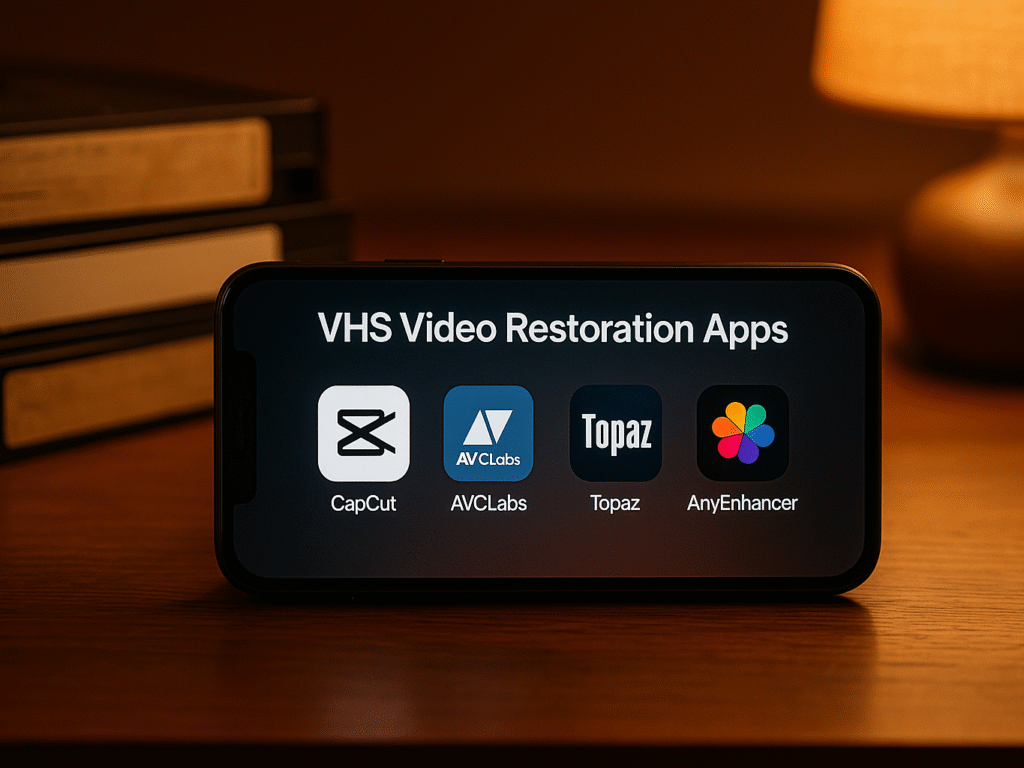
These top-rated VHS video restoration apps, personally tested, deliver powerful results restoring faded footage, repairing damage, and enhancing old memories with ease. Perfect tools to digitize and preserve tapes in 2025.
1. AnyEnhancer
AnyEnhancer stands at the forefront of mobile VHS video restoration apps, utilizing cutting-edge AI technology to breathe new life into deteriorating tapes. This powerful tool has gained popularity for its ability to transform grainy, low-quality footage into crisp, vibrant videos that exceed the original quality.
(i) AI-powered upscaling to 4K
Nowadays, AnyEnhancer’s advanced AI algorithms can transform standard definition VHS footage into stunning 4K resolution. The software utilizes deep learning to intelligently add pixels, enhance edge sharpness, and restore intricate details, making old videos look remarkably modern. This upscaling process works by analyzing your video frame by frame, identifying patterns and elements that require enhancement.
The resolution enhancement model specifically targets clarity issues common in VHS tapes. By selecting either 2K or 4K output options, you can dramatically improve visual quality without creating artificial-looking results. This technology not only magnifies the image but also reconstructs missing details lost due to tape degradation, delivering exceptional clarity that was previously impossible with traditional enhancement methods.
(ii) Face restoration and color enhancement
Beyond general upscaling, AnyEnhancer excels at face restoration, a critical feature when preserving family memories. The app’s specialized face restoration technology can automatically identify, analyze, and restore blurry facial features in your VHS footage. Throughout the restoration process, it carefully enhances eyes, noses, mouths, and skin textures while maintaining natural appearances.
On top of that, AnyEnhancer offers two powerful color-related features:
- Color Enhancement: Revitalizes faded, washed-out colors to make scenes more vibrant
- Colorize: Brings realistic color to black-and-white VHS tapes by intelligently identifying objects and people
These tools work together to recover the true essence of your memories, making decades-old footage appear as if it were recorded with modern equipment.
(iii) Best for one-click restoration
What truly distinguishes AnyEnhancer is its remarkable simplicity despite its sophisticated technology. The 100% automatic AI processing delivers professional-grade enhancements with virtually no manual effort required. First-time users can achieve impressive results without prior video editing experience. Simply upload your digitized VHS file, select an enhancement model, and let the app do its magic.
The intelligent enhancement option is particularly valuable for VHS restoration, as it simultaneously improves resolution and refines human faces in a single operation. Indeed, the real-time preview feature allows you to evaluate enhancements before committing to the export process, ensuring you get precisely the results you want.
For those digitizing numerous family VHS tapes, AnyEnhancer proves to be a reliable VHS video restoration app. Its straightforward workflow saves countless hours compared to traditional methods, automatically correcting common VHS issues like grain, color degradation, and image noise, making it an excellent choice for preserving your most treasured recorded memories.
2. AVCLabs Video Enhancer AI
Looking under the hood of AVCLabs Video Enhancer AI reveals a technical powerhouse explicitly designed for serious VHS restoration projects. This sophisticated tool utilizes multiple artificial intelligence models to address the most common issues encountered in degraded VHS tapes, making it particularly valuable for challenging restoration tasks.
(i) Frame-by-frame enhancement
AVCLabs Video Enhancer AI meticulously processes each frame individually using a combination of advanced neural networks. The software leverages sophisticated AI models, including CNN, RNN, and LSTM, to analyze patterns and structures within your footage. This frame-by-frame approach enables the exact reconstruction of details, which bulk processing cannot match.
The technology employs GAN (Generative Adversarial Network) systems to recover lost texture and detail in low-resolution or degraded videos. Throughout the enhancement process, the AI identifies underlying patterns in your VHS footage and intelligently reconstructs missing information. It enables upscaling capabilities that can transform standard-definition VHS content to 8K resolution with frame rates of up to 120 FPS.
(ii) Noise reduction and sharpening
Alongside standard enhancement, AVCLabs excels at intelligent noise reduction, a critical feature for VHS tape restoration. The dedicated AI Denoise Model intelligently distinguishes between actual video details and unwanted noise. In essence, this prevents the common problem of detail loss during noise removal that plagues many standard restoration tools.
The software’s denoising capabilities work in conjunction with its sharpening technology to:
- Enhance contrast without creating unnatural artifacts
- Preserve edge details while removing grain
- Apply Super Resolution techniques to enhance clarity
- Process multiple videos simultaneously via batch processing
This balanced approach ensures your restored VHS footage maintains its authentic character while eliminating distracting visual noise.
(iii) Great for restoring VHS tapes with motion blur
Where AVCLabs truly stands out is in handling motion blur, one of the most challenging aspects of VHS restoration. The software employs motion-aware stabilization to analyze camera movement frame by frame. Hence, it can correct shaky footage without resorting to extreme cropping or introducing warping artifacts.
The dedicated Motion Compensation Model in this VHS video restoration app uses advanced motion estimation to reduce blur by analyzing movement patterns. It’s especially useful for restoring shaky home videos or footage with VCR tracking issues. Even heavily blurred scenes become watchable again, without requiring manual input or technical expertise.
For those digitizing multiple VHS tapes with varying quality issues, AVCLabs offers versatility without sacrificing processing speed, thereby making it an excellent choice for preserving your most precious analog memories.
VHS Video Restoration Cost in 2025: DIY vs. Professional Pricing Explained. Compare restoration costs, understand pricing factors, and determine whether DIY mobile apps or professional services offer the best value for your specific tape collection and budget requirements. Make informed decisions about your restoration investment strategy.
3. Topaz Video Enhance AI
Among professional video enthusiasts restoring VHS tapes, Topaz Video Enhance AI stands out as the heavyweight champion of quality enhancement. This sophisticated tool harnesses multiple specialized AI models to transform degraded footage into self-explanatory videos that preserve every recoverable detail from your old tapes.
(i) Advanced AI models for detail recovery
Topaz Video Enhance AI offers a comprehensive suite of specialized AI models, each designed to address specific challenges in VHS restoration. The software includes several purpose-built models for analog video sources:
- Proteus: General-purpose enhancement with customizable settings for sharpening and detail recovery
- Iris: Specialized for low-quality footage with superior noise handling capabilities
- Dione DV/TV: Specifically trained on interlaced video common in VHS recordings
What makes these models exceptional is their ability to analyze video on a frame-by-frame basis, intelligently distinguishing between noise and actual detail. Forthwith, this prevents the common problem where traditional enhancers remove important visual information along with unwanted noise. For VHS tapes containing faces, the software’s face enhancement technology can sharpen and restore facial features with remarkable accuracy.
(ii) Upscaling to 8K
Chiefly, Topaz excels at achieving dramatic resolution improvements, potentially transforming standard-definition VHS content to resolutions of up to 8K. The software accomplishes this through intelligent algorithms that generate new pixels based on surrounding content rather than simply stretching existing information.
In addition to resolution enhancement, Topaz offers:
- Denoising capabilities that remove grain, flicker, and interlaced lines
- Frame interpolation to increase smoothness by creating additional frames
- Stabilization to fix shaky footage using AI-based motion analysis
For optimal results with VHS footage, users report achieving the best outcomes by using a multi-step approach: first, deinterlacing the video, and then applying upscaling models like Proteus or Iris with customized settings. This methodical approach yields significantly better results than one-pass processing, essentially transforming 480p noisy, jittery videos into crisp, stabilized HD with minimal user intervention.
(iii) Ideal for high-end mobile devices
Undeniably, Topaz demands substantial computing resources compared to simpler VHS restoration apps. The software requires a reasonably powerful mobile device, ideally with:
- A dedicated GPU with at least 6GB VRAM
- 16GB system memory (32GB recommended)
- Modern CPU with AVX instructions
Compared to many entry-level restoration tools, these requirements exceed them. Nonetheless, for those with capable mobile hardware, the results justify the resource demands. The software utilizes GPU acceleration to reduce processing time on supported devices dramatically.
To maximize performance on mobile platforms, the company has partnered with leading hardware manufacturers, including Nvidia, AMD, and Intel, to optimize processing speeds. For users with less powerful devices, Topaz also offers cloud rendering options that offload processing demands to remote servers.
4. 4DDiG Video Repair
When digitized VHS tapes become corrupted or unplayable, 4DDiG Video Repair stands out as a specialized VHS video restoration app. It goes beyond basic enhancement by recovering severely damaged files that many other tools can’t fix. This makes it essential for rescuing irreplaceable video memories.
(i) Fixes corrupted or unplayable video files
4DDiG Video Repair utilizes AI-powered algorithms specifically designed to address a wide range of video corruption issues. The software effectively fixes choppy, jerky, or flickering motion in videos, restoring a seamless playback experience. For VHS tapes with severe damage, it can repair issues like audio-video sync problems, frozen frames, missing sound, and blurry or pixelated footage.
What sets this app apart is its ability to handle multiple corruption scenarios. The tool can repair corrupted headers, broken indexes, and missing frames, common problems when digitizing deteriorated VHS tapes. Remarkably, 4DDiG can even resolve video playback error codes that typically render files completely inaccessible.
(ii) Supports multiple formats
Flexibility with file formats makes 4DDiG particularly valuable for VHS restoration projects. The app works with numerous video formats, including:
- Standard formats: MP4, MOV, AVI, MKV
- Legacy formats: 3GP, 3G2, FLV, MPEG
- Professional formats: MTS, MXF, RMVB, SWF
Beyond format compatibility, 4DDiG works with videos from virtually any source device. The software supports footage from popular camera brands, including Canon, Nikon, Sony, GoPro, and DJI drones. Furthermore, it can process files from any storage media, including hard drives, SD cards, USB devices, and more.
(iii) Best for damaged VHS conversions
4DDiG excels at rescuing severely compromised VHS conversions. The app thoroughly analyzes and repairs video data regardless of how it was corrupted. Unlike other tools that primarily enhance visual quality, 4DDiG focuses on structural repair, making it invaluable for tapes with extensive physical deterioration.
The software excels when handling files that appear completely unplayable after digitization. Its comprehensive repair capabilities can restore videos with corrupted headers, a common issue when VHS tapes have degraded magnetic information. Undoubtedly, the most significant advantage is the app’s intuitive interface, which guides users through the repair process without requiring technical expertise.
5. Wondershare Filmora
For those seeking a more straightforward approach to VHS restoration, Wondershare Filmora strikes a balance between accessibility and capability. This versatile video editor offers basic restoration features, making it a practical option for novice users working with moderately degraded tapes.
(i) Beginner-friendly interface
Primarily designed for users with no prior video editing experience, Filmora presents an intuitive interface that doesn’t succumb to technical options. The straightforward layout organizes tools into logical categories, such as video effects, color correction, and stabilization. Of course, this design philosophy makes it particularly valuable for first-time restorers who might find specialized VHS restoration software intimidating.
The app provides convenient templates specifically for VHS restoration projects. By searching “VHS” in the template section, you can quickly apply pre-configured VHS filters that simulate classic tape effects or enhance existing ones. Afterward, you can fine-tune these templates to match your specific footage, giving you creative control without requiring technical expertise.
(ii) Basic color correction and stabilization
Filmora’s color correction toolkit covers all the essential adjustments needed to restore faded VHS footage. The software enables you to adjust brightness, saturation, contrast, exposure, vibrance, and white balance using simple slider controls. These tools help revive the washed-out colors typically found in older VHS recordings.
The built-in stabilization feature addresses another common VHS issue: shaky footage. Using a VHS video restoration app, once you’ve imported your digitized tape, the stabilization tool analyzes movement patterns and applies corrections that significantly reduce camera shake. Generally, this works through a simple three-step process: analysis, strength adjustment, and application. You can choose between weak, normal, or strong stabilization, depending on the quality of your footage.
(iii) Suitable for light restoration tasks
Filmora works best for VHS tapes with moderate degradation rather than severely damaged footage. The software excels at basic enhancements, such as fixing color fading, reducing mild noise, and applying modest sharpening. Alternatively, for more challenging restoration jobs, the specialized AI tools mentioned earlier in this article might be better suited.
What makes Filmora valuable for casual VHS restoration is its availability across platforms. The app is compatible with both iOS and Android mobile devices, ensuring accessibility regardless of your preferred mobile operating system. This cross-platform capability allows you to start a restoration project on your phone and continue working on it from another device if needed.
Top VHS Video Restoration Software (Free & Paid) for Every Skill Level: Explore comprehensive software comparisons, feature breakdowns, and skill-level recommendations to find the perfect restoration solution matching your technical expertise and project requirements. Discover both free and premium options available.
6. HitPaw Video Enhancer
HitPaw Video Enhancer (recently rebranded as VikPea) strikes the perfect balance between powerful AI capabilities and user-friendly operation for your VHS restoration projects. This straightforward tool makes vintage footage restoration accessible through intelligent algorithms that tackle common VHS deterioration issues without requiring technical expertise.
(i) AI models for face, general, and animation
HitPaw’s specialized AI models target specific restoration challenges with remarkable precision. The Face Model excels at repairing and enhancing human facial details in your family VHS recordings, making blurry subjects recognizable again. Meanwhile, the General Denoise Model removes the characteristic noise from old tapes while preserving crucial visual information. For enthusiasts with animated content, the Animation Model perfectly restores clarity in cartoon footage.
Beyond these core models, HitPaw offers additional restoration capabilities through its Video Quality Repair Model, which removes unwanted flickering and scratches from damaged VHS conversions. The Frame Interpolation Model works in conjunction with a Stabilization Model to reduce choppiness in your footage.
(ii) Real-time preview before export
One standout feature is HitPaw’s convenient preview function that lets you evaluate enhancements before committing to lengthy processing. The software enables you to preview 3-5 seconds of your enhanced video with a single click, displaying side-by-side comparisons of the original and improved footage. This instant feedback helps you select the optimal restoration settings without wasting time on complete processing.
(iii) Best for social media-ready restorations
HitPaw particularly shines in creating shareable, polished content from your VHS archives. The intuitive three-step process, import, select model, export, transforms deteriorated footage into content ready for modern platforms. Furthermore, the software supports upscaling to 4K resolution, making your vintage memories compatible with today’s displays and social media standards.
Batch processing capabilities allow you to enhance multiple VHS clips simultaneously, saving considerable time when digitizing entire tape collections. This efficiency, combined with the straightforward interface, makes HitPaw an excellent choice for quickly transforming nostalgic VHS moments into shareable memories.
7. Aiseesoft Filmai
Designed to breathe new life into deteriorated analog footage, Aiseesoft Filmai stands out as a comprehensive VHS video restoration app that strikes a balance between sophisticated features and straightforward operation. This versatile software excels at converting grainy family memories into crisp, modern videos through its powerful AI-enhancement tools.
(i) Color correction and upscaling
Aiseesoft Filmai performs remarkably well at video color correction, quickly balancing hues, saturation, and brightness to ensure consistency throughout your VHS footage. The software’s powerful AI upscaling capabilities can enlarge videos to 2×, 4×, or even 8× their original resolution without compromising quality. Additionally, for videos affected by frame loss, Filmai’s frame interpolation technology produces smoother, more fluid playback.
(ii) Works on both Mac and Windows mobile platforms
A significant advantage of Aiseesoft Film Maker is its cross-platform compatibility, supporting both Windows (11, 10, 8, 7) and macOS 10.14 or higher. Through a simple interface, you can import videos, select enhancement options, and preview results before exporting to various formats, including MP4, MKV, WEBM, and GIF.
(iii) Great for restoring black-and-white VHS
Filmai truly shines when working with monochrome footage. Its specialized AI models are explicitly designed to enhance and colorize black-and-white videos, bringing out subtle details while improving overall clarity. The colorization tool transforms vintage recordings into vibrant, natural-looking footage that preserves the authentic feel of your original memories.
8. Nero AI Video Upscaler
Nero AI Video Upscaler emerges as the ideal solution for home users who want to preserve their family memories without needing professional equipment. This accessible tool transforms your aging VHS content into modern, high-resolution videos through intelligent AI processing.
(i) Specializing in VHS upscaling
Nero AI Video Upscaler employs deep learning models trained on thousands of videos to accurately upscale low-resolution footage to stunning 4K or even 8K resolution. The software excels at recognizing and enhancing the typical issues found in VHS tapes, injecting real details into video, and sharpening blur with just one click. Its sophisticated AI algorithms analyze each frame, restore lost information, and sharpen edges, making old footage look crisp and clear.
(ii) Step-by-step guided process
The VHS restoration process with Nero follows a straightforward three-step approach.
- Initially, connect the Nero Recode Stick to your computer via USB, then to your analog video source, such as a VCR.
- Afterward, you simply import the digitized video into the Nero AI Video Upscaler app.
- Select your desired output resolution and AI model, then click “Upscale video” to begin processing.
(iii) Best for users digitizing tapes at home
Indeed, what makes Nero stand out is its perfect pairing with the Nero Recode Stick, creating a complete home digitization solution. Home users appreciate the software’s multiple AI models optimized for different content types: Fast for quick projects, Animation for cartoons, and Realistic for natural footage. Unlike many alternatives, Nero doesn’t add watermarks to your videos, ensuring your precious memories remain untarnished.
How to Restore VHS Videos for Free: Best No-Cost Tools in 2025: Access free restoration solutions, learn about open-source alternatives, and discover budget-friendly methods for preserving your VHS collection without spending money on premium software. Start your restoration journey without financial barriers.
Final Thoughts
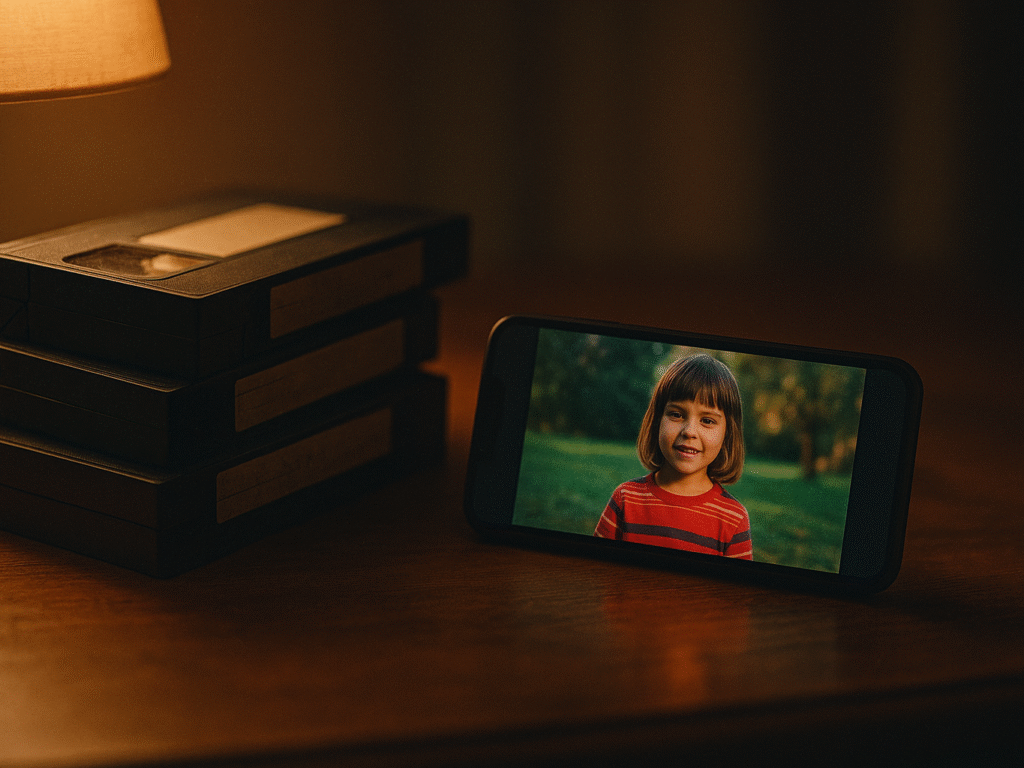
Time races forward, but your VHS memories fade quietly in the background. Thankfully, a VHS video restoration app can help. These mobile apps now offer powerful AI tools that make restoring old tapes easier than ever. With minimal effort, you can transform grainy, washed-out footage into crisp, vibrant videos and revive precious moments that might otherwise fade away with each passing year of magnetic media decay.
Each restoration app offers distinct strengths. AnyEnhancer delivers fast, one-tap AI upscaling, while AVCLabs excels with motion blur correction. For top-tier quality, Topaz Video Enhance AI is suited for advanced users, while 4DDiG Video Repair handles corrupted files. From Filmora’s beginner-friendly UI to Nero’s hardware-integrated system, there’s a tool for every skill level and tape condition.
Choosing the right tool depends on your needs. Consider your tape’s condition, desired output, and level of comfort with technology. Whether you’re digitizing tapes for archival or sharing clips online, acting now is critical. For detailed guidance on preserving your VHS collection, these apps provide the perfect starting point. These apps won’t just enhance your videos, they’ll preserve memories for future generations. Start your preservation journey before your family’s history slips away forever.
FAQs on VHS video restoration app
Q1. What are the best mobile apps for restoring VHS videos?
Some of the top mobile apps for VHS video restoration include AnyEnhancer, AVCLabs Video Enhancer AI, Topaz Video Enhance AI, 4DDiG Video Repair, and HitPaw Video Enhancer. These apps offer features such as AI-powered upscaling, noise reduction, color correction, and frame-by-frame enhancement to enhance the quality of old VHS footage.
Q2. Can AI technology improve the quality of old VHS tapes?
Yes, AI technology can significantly enhance the quality of old VHS tapes. Advanced AI models can upscale resolution, reduce noise, sharpen details, correct colors, and even restore damaged or corrupted footage. Some apps can transform standard definition VHS content to 4K or even 8K resolution, dramatically improving visual clarity.
Q3. What should I look for in a VHS restoration app?
When choosing a VHS restoration app, look for features like ease of use, AI-powered upscaling and denoising capabilities, compatibility with digitized VHS file formats, and color correction tools. Additionally, consider whether the app offers real-time previews, batch processing, and the ability to handle common VHS issues, such as interlacing and motion blur.
Q4. Is it possible to colorize black-and-white VHS footage?
Yes, some VHS restoration apps offer colorization features for black-and-white footage. For example, Aiseesoft Filmai has specialized AI models designed to enhance and colorize monochrome videos, transforming vintage recordings into vibrant, natural-looking footage while preserving the authentic feel of the original memories

